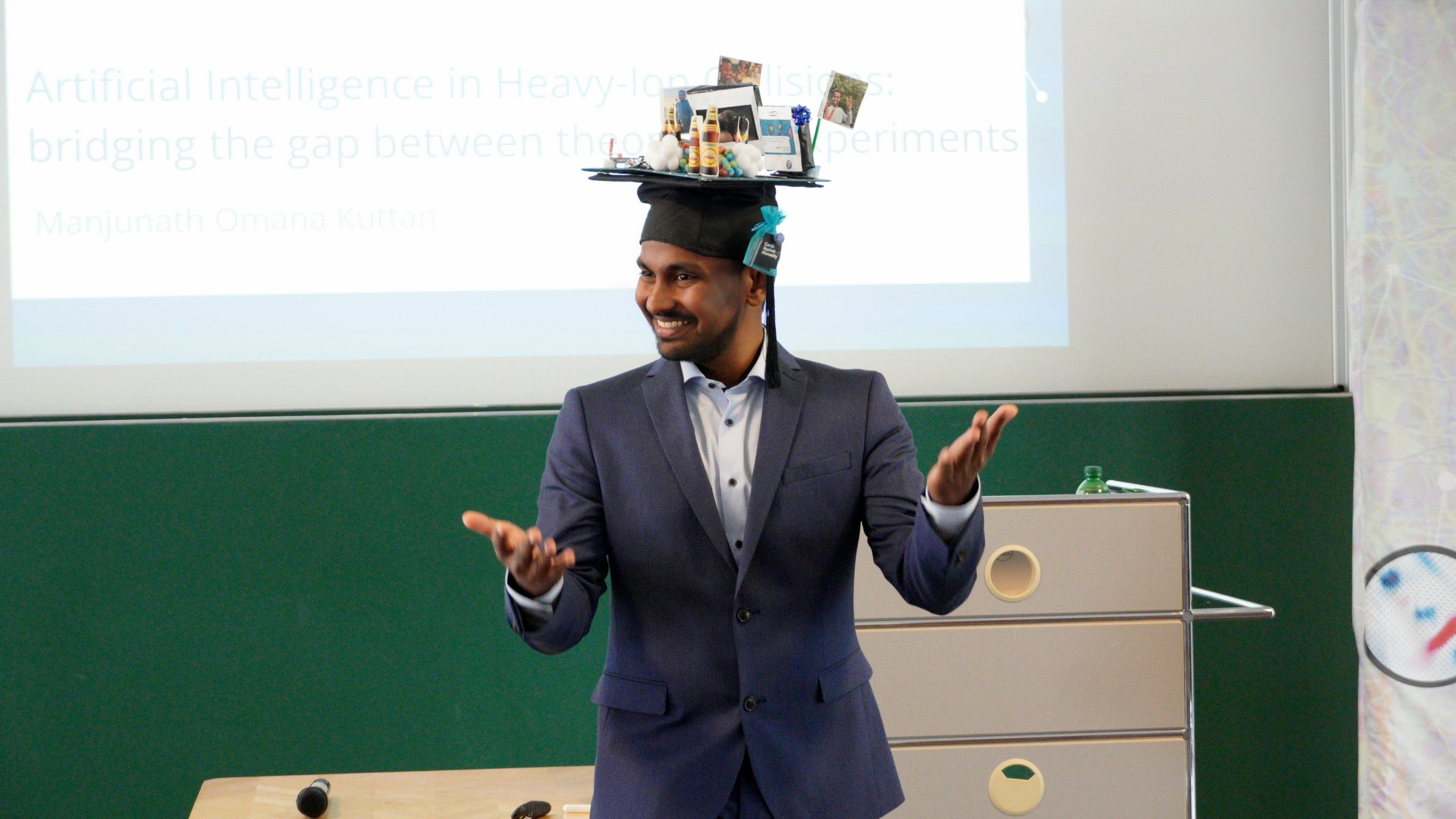November 3, 2023
Doctoral defense of Manjunath Omana Kuttan
Artificial intelligence in heavy ion collisions: Linking theory and experiment
At the end of October, Manjunath Omana Kuttan successfully defended his doctoral thesis at Goethe University's Department of Physics. Omana Kuttan finalized his PhD after three and a half years in the Deepthinkers group at FIAS, supervised by FIAS Senior Fellow Horst Stöcker and FIAS Fellows Jan Steinheimer and Kai Zhou.
Omana Kuttan's next article, which adds to his already long list of publications, has just been highlighted as Editors' Suggestion in the journal Physical Review Letters (1). His PhD thesis focused on studying the limitations of conventional analysis methods used to study the physics of strongly interacting nuclear matter and developing methods to overcome them. The aim was to develop Artificial Intelligence (AI) techniques to analyze high-energy heavy ion collisions. To this end, he developed models based on Point Cloud Network which can determine the centrality and Equation of State (EoS) of collisions directly using experimentally measured tracks or hits of charged particles in the detector.
The EoS, in simpler words, tells you how the pressure of the system created in collisions varies as a function of energy densities and baryon densities. As pressure gradients drive the evolution of the hot-dense matter created in the collisions, extracting the EoS is crucial in understanding the properties of hot and/or dense nuclear matter and is therefore one of the major goals of heavy-ion collision experiments. Another important result of his PhD was the constraints on the high density EoS, extracted through Bayesian inference. The analysis not only showed that the intermediate energy heavy-ion collision data can yield tight constraints on the high density EoS but also demonstrated the necessity of future high precision measurements for unambiguous determination of the EoS. These latest Bayesian Inference results will complement astrophysical studies to extract the EoS of strongly interacting matter from Neutron Star observations and binary neutron star merger signals.
The physicist, born and educated in India, thus develops and uses AI methods to improve the understanding of strongly interacting matter using experimental heavy ion collision data, the results of which will be important for future experiments, for example at the FAIR accelerator in Darmstadt. His start at FIAS was challenging at first: "not only academically - but I also had to adapt to a new city, language, culture, and even weather". The support of his mentors and colleagues helped, he says: "I enjoyed doing my PhD in the healthy, fun and at the same time strong academic atmosphere in our FIAS group." Omana Kuttan will stay at FIAS as post-doc, developing ultra-fast simulation techniques for heavy ion collisions using Deep Learning. FIAS congratulates and is looking forward to further co-operation!
Selected Publications:
- Omana Kuttan, M., Steinheimer, J., Zhou, K., & Stoecker, H., The QCD EoS of dense nuclear matter from Bayesian analysis of heavy ion collision data. arXiv preprint arXiv:2211.11670. (Accepted in Phys. Rev. Lett.)
- Omana Kuttan, M., Steinheimer, J., Zhou, K., Redelbach, A., & Stoecker, H., A fast centrality-meter for heavy-ion collisions at the CBM experiment. Phys.Lett.B 811 (2020) 135872
- Omana Kuttan, M., Zhou, K., Steinheimer, J., Redelbach, A., & Stoecker, H., An equation-of-state-meter for CBM using PointNet. J. High Energ. Phys (JHEP) 10 (2021) 184
- Omana Kuttan, M., Motornenko, A., Steinheimer, J., Stoecker, H., Nara, Y., & Bleicher, M., A chiral mean-field equation-of-state in UrQMD: effects on the heavy ion compression stage. Eur.Phys.J.C, 82(5), 427
- Omana Kuttan, M., Steinheimer, J., Zhou, K., Bleicher, M., & Stoecker, H., Model dependence of the number of participant nucleons and observable consequences in heavy-ion collisions. Eur.Phys.J.C 83 (2023) 9, 792
